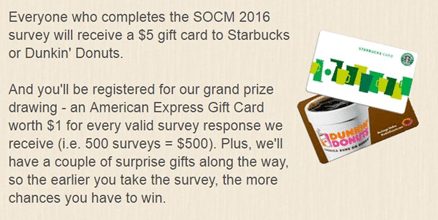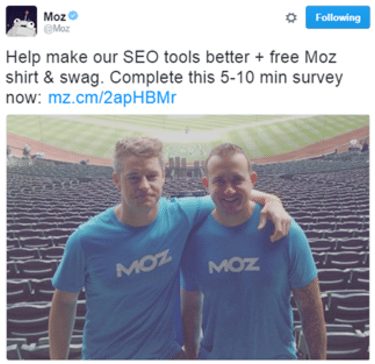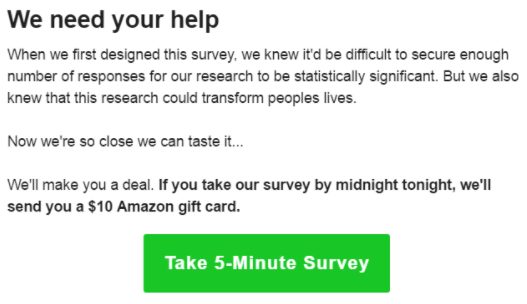November 8, 2016
Survey Response Rates
Most marketers who conduct survey research are looking for actionable insights. Creating an effective online survey is a great first step. But your insights won’t be actionable unless your research is credible. One way to increase the credibility of your results is to boost your survey response rates. That’s right: The more people who complete your survey, the more accurate your research becomes.
Benchmarking your online survey response rates
Online survey response rates range from 2% to 85%—making it difficult for marketers (like you) to evaluate performance. After all, that’s a huge range! Let’s look at some industry examples to help you benchmark:
- Satmetrix Chief Customer Officer Deborah Eastman claims that average online survey response rates range from 13% to 16% for B2C companies and 23% to 32% for B2B companies (depending on the type of survey). For example, B2C companies get higher response rates for transactional surveys, whereas B2B companies get higher response rates for surveys that measure relationship health.
- SurveyMonkey claims that survey response rates can be as high as 30%—even if you don’t have a prior relationship with the respondents.
- The team at Kapost was disappointed when their first online survey received response rates below 2.6%. Multiple sources had reported industry averages between 10% to 40%. They asked themselves: Why was our experience so different? After speaking with others in the industry, they realized the industry average for non-customer group surveys is much lower. In reality, their survey had an above average response rate!
- The Content Marketing Institute’s Research Director Lisa Beets reported survey completion rates between 0.5% to 1% for their annual benchmarking survey.
- SurveyGizmo suggests that online survey response rates differ depending on whether or not they’re internal or external. In their experience, internal surveys see response rates between 30% and 40%, whereas external surveys receive response rates between 10% and 15%.
What factors impact survey response rates?
A few weeks ago, you learned how to create an effective online survey. In that post, we outlined a few factors that impact survey response rates, such as:
- The length of the survey
- The complexity of the questions
- The frequency of your requests
- The design of your survey
What other factors influence response rates, you ask?
1. Target population
Some populations are simply more difficult to reach than others. For example, Fortune 500 CMOs are highly sought after research subjects. As executives, they simply don’t have time to participate in a new research study every week. They also likely suffer from respondent fatigue due to their popularity—making it unlikely that they’ll even open your email. Hence why targeting this population will (almost certainly) decrease your online survey response rates.
2. Researcher and sponsor identities
The identities of the researcher (the person who designs the survey) and the sponsor (the person who asks people to complete the survey) also impact your response rates. In 2013, a group of scholars conducted an experiment. They measured whether A) the name of the researcher, and B) the institution they belonged to had an impact on survey response rates. The results? English-language surveys designed by researchers with common Christian names from well-known institutions got significantly higher response rates. This experiment was later published in the Journal of Hospitality & Tourism Research. The lesson? Respondents are more likely to complete your survey if it’s designed (and delivered) by someone who is high-profile, but also familiar to them. For example, a state of customer journey marketing survey designed by an influential CMO with an advanced research degree is going to be more effective than a similar survey designed by someone with limited marketing experience (e.g. a junior accountant) and less credibility (i.e. no research training). Your organization’s relationship with the respondent can also have a big impact. For example, surveys sent to employees and customers will see much higher response rates than surveys administered to complete strangers. 
3. Incentive(s) offered
Offering an incentive that’s appealing to your target population can significantly increase your online survey response rates. For example, one study found that offering a $5 financial incentive boosted response rates by 34% (if promised) and 52% (if prepaid). That’s a big change! Incentives come in two forms: Financial incentives include everything from cash to coupons and gift cards.  Material incentives include everything else, such as brand swag or a donation to the charity of the respondent’s choice.
Material incentives include everything else, such as brand swag or a donation to the charity of the respondent’s choice. 
4. Email content and length
The content and length of your email has a big impact on online survey response rates. If your email is too long, you may give the impression that you don’t respect the respondents’ time. Contently author Susan Johnston Taylor saw a 107% increase in her email response rate after beginning to use Respondable (a new tool by Boomerang). “Based on data from millions of emails, Respondable uses artificial intelligence to rate the likelihood of an email getting a response,” she explains. According to Respondable’s guidelines, you should limit your email to 250 words or less. On the other hand, if your email is too short, you may not have explained the purpose of your research adequately. Or you may have failed to motivate the individual to participate in your survey. One way to encourage participation is by personalizing your email. It can be as simple as using the individual’s first name in the subject line and addressing them directly in the email.  It’s an effective tactic: In a study conducted by the Center for Survey Methodology, personalization increased response rates by 7.8%.
It’s an effective tactic: In a study conducted by the Center for Survey Methodology, personalization increased response rates by 7.8%.
What emails to send (and what they should say)
****1. The Precontact
In this email, you’re simply going to let people know that they’ll be receiving a request to participate in your survey.  Many marketers skip this step, but it’s actually really important. The precontact email helps you establish trust with your audience by explaining the purpose of your research, the topic you’re investigating, and why their contribution is important.
Many marketers skip this step, but it’s actually really important. The precontact email helps you establish trust with your audience by explaining the purpose of your research, the topic you’re investigating, and why their contribution is important.
2. The Ask
In this email, you’ll pop the question for the first time. But you’ll also outline the benefits of participating in your research. This is a great example:  Why? Because Guy effectively answers the question, _What’s in it for me?_ Respondents who choose to participate in his research study will get a free copy of his report, which outlines:
Why? Because Guy effectively answers the question, _What’s in it for me?_ Respondents who choose to participate in his research study will get a free copy of his report, which outlines:
- What’s working in marketing
- Where companies invest their resources
- What top marketers do differently
And if they move quickly, they’ll also get a $10 Amazon gift card. The takeaway here? Do everything you can to motivate the recipient to complete your survey.
3. Reminder #1
The first reminder is a friendly reminder. In this email, you’ll want to reiterate the benefits of participating. But this time, add a new call-to-action that prompts recipients to schedule time in their calendar to complete the survey.  This tactic will help you get responses from those who truly want to participate but become distracted before they get a chance to.
This tactic will help you get responses from those who truly want to participate but become distracted before they get a chance to.
****4. The Extension
It’s been a few days, and you’ve yet to get an adequate number of responses. You’ve already sent a reminder, so you don’t want to appear pushy. What do you do? You send an email announcing the extension of your survey. In the email, explain that you’re “almost there” (if they’re invested in your success, they’ll want to help) and offer a new (small, but guaranteed) incentive to the next wave of respondents. To ensure they respond right away (as opposed to putting it off again), provide a tight deadline (e.g. midnight tonight). 
5. Reminder #2
This reminder is a follow-up to the extension email above. Send it to anyone who has yet to complete the survey 1-3 hours before the deadline. What strategies do you use to boost your online survey response rates? Let us know in the comments.













